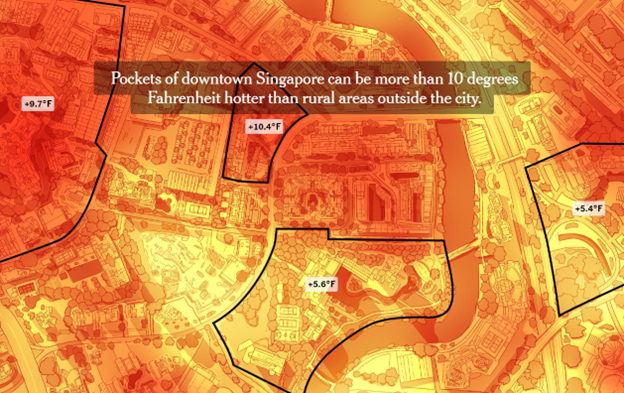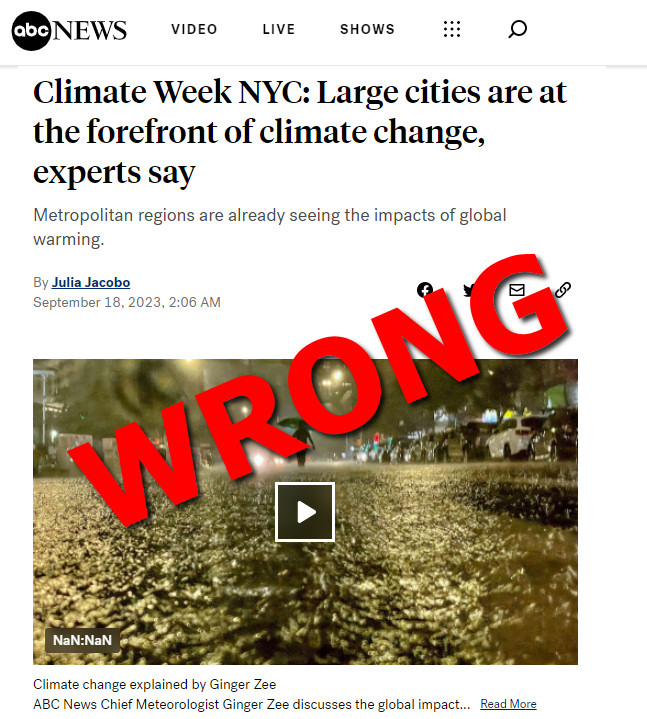A September 18th article by ABC News claims that “America’s largest cities are at the forefront of climate change.” The article also claims: “Extreme heat is one of the most clearly recognized signals of climate change.” This is false. Almost all cities are subject to the urban heat island (UHI) effect, which creates a localized warming due to the infrastructure, and science has clearly defined this as being a localized effect of the city itself and nothing to do with climate change.
In addition to hotter cities, the article goes on to falsely claim that local flooding in cities is also due to climate change. In fact, evidence and data demonstrates that land subsidence and poor drainage resulting from bad planning decisions, among other local factors, are responsible for flooding in urban areas, not climate change.
The UHI effect is well known and intensely studied. Unfortunately, many so-called journalists don’t have the training to understand the difference between a city warmed by UHI versus a city warmed by climate change and thus make broad assumptions that are not supported by evidence.
In the case of ABC News, they clearly spell out the source of the issue but refused to acknowledge the fact that climate change has nothing to do with it. ABC News says:
Urban environments are prone to overheating because of the lack of greenery and abundance of concrete, which absorbs the heat and does not release it easily, creating the phenomenon known as an urban heat island. Heavy traffic also contributes to air pollution, which helps to trap the heat even more.
This parallels official government statements (such as from the Environmental Protection Agency) and is documented in Climate at a Glance: Urban Heat Islands and as illustrated in Figure 1 below:

Urban heat islands, which grow along with the size of cities, create artificial warming at many long-term temperature stations. Data shows 96 percent of the temperature stations in the United States fail to meet the National Oceanic and Atmospheric Administration’s standards for uncorrupted placement. On average, urban heat islands increase the local surface temperature trend by almost 50 percent.
This is not just a problem for the United States in cities such as New York. For example, a New York Times (NYT) interactive web article illustrates how the city of Singapore can be ten degrees warmer than surrounding areas as seen in Figure 2:

Sadly, the NYT, in its article, “How to Cool Down a City,” acknowledges and then downplays the UHI’s role in Singapore’s temperature trend, just like with ABC News did in its article.
ABC News also asserted, “Several consequences of climate change are causing increased flooding in cities.” But, ABC News then ignores the leading causes of flooding in cities; land subsidence, and cities’ inadequate infrastructure to handle runoff during storms.
For example, as pointed out in this Climate Realism piece, “The Nation Flounders on Miami Sea-Level Rise Story”:
Miami’s real problem isn’t rising seas as much as land subsidence. Much of Miami was built on reclaimed swamp land, and then built up with modern infrastructure. That extra weight causes a sinking of the land, known as subsidence, allowing seawater to seep in when the surfaces sink to near sea-level. It also means that during strong rainfall events, and hurricane storm surge, areas that have subsided don’t drain as they did years before.
This is clearly covered in the scientific paper Land subsidence contribution to coastal flooding hazard in southeast Florida, published in Proceedings of IAHS in 2020.
The same sort of problem exists in New York City, as pointed out by a study done by the University of Rhode Island:
Subsidence has been occurring where New York City now sits since the end of the last ice age. As the ice sheets retreated, the land once covered by the ice, north of the city, began to rise and the land that was just south of the ice, where New York City is today, began to sink.
…
The results indicate that in recent years, all of New York City is sinking about 1 to 2 millimeters per year due to post-glacial relaxation. However, some parts of the city, particularly where buildings are built on fill and sediment, are sinking faster, up to 4 millimeters per year. While the massive weight of the buildings causes some of the subsidence, not all of the increased subsidence rate can be directly attributed to the buildings. According to the study, subsidence due to buildings usually stops within a year or two of construction. Continuation of subsidence past that time is largely due to other processes, such as withdrawal of groundwater.
Once again, local effects of the city itself are larger than any impact of climate change, which has yet to be identified clearly and measured.
ABC News points out in the article the other problem, drainage, even though they falsely claim climate change is the driver of the flooding issue:
The prevalence of concrete also contributes to the flooding, as there is no soil to help absorb the excess water, Madajewicz said. The lack of wetlands and dunes in coastal areas that have been heavily developed, such as the Rockaways in Queens, make those neighborhoods more susceptible to flooding, especially when a major storm comes in, like Tropical Storm Sandy in 2012.
The bottom line is that cities have altered the local environment over time as infrastructure and housing was built. The impact of these actions is clear and identifiable. By contrast, any contribution of the Earth’s modest average temperature rise to localized sharp temperature increases and individual flooding events is speculative at best, with no supporting data to back such a causal connection. Unfortunately, reporters and editors seem resistant to reporting the facts, instead preferring to push a false climate crisis narrative.
















